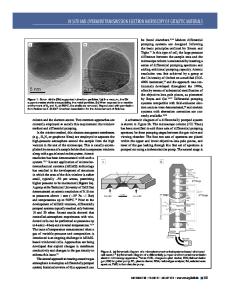In situ transmission electron microscopy observation of reversible deformation in nacre organic matrix
- PDF / 564,116 Bytes
- 6 Pages / 585 x 783 pts Page_size
- 13 Downloads / 400 Views
Yusuke Owaki and Yutaka Kagawa Research Center for Advanced Science and Technology, University of Tokyo, Meguro, Tokyo 153-8904, Japan (Received 2 October 2007; accepted 22 February 2008)
The deformation behavior of the organic polymer matrix of the biocomposite nacre structure in abalone shell was investigated by in situ straining during transmission electron microscopy (TEM). We observed strong adhesion to mineral plates and high ductility of the organic matrix, confirming a crack-bridging toughening mechanism. In addition, direct observation of reversible mechanical behavior was made in the viscoelastic reformation of matrix ligaments after failure. Crystalline -sheet structures identified through electron diffraction suggested the presence of protein structures similar to spider or cocoon silk, and the reversible mechanism was attributed to hydration-induced unfolding and refolding of domains in these silklike proteins. This work provides further insight into the molecular and nanoscale behavior of nacre organic matrix and its contribution to bulk mechanical performance.
I. INTRODUCTION
The characteristic nanocomposite “brick and mortar”1,2 structure of nacre is illustrated in Fig. 1. It is made up of predominantly (over 95% by volume) uniformly oriented, ordered layers of platelike aragonite CaCO3 separated by thin organic polymer matrix and achieves fracture toughness orders of magnitude greater than the pure mineral.3 This high mechanical performance has been attributed to mechanisms between plates such as sliding/pullout and crack deflection/stopping,3–8 friction between rough surfaces,7,9,10 mineral bridges between plates,6,9,11,12 and interlocking.9,13 The crack bridging toughening mechanism of the organic matrix has been observed as ligaments stretch between separated plates,3,7,8,14 and recent models have taken into account the mechanical contribution of the matrix.15,16 Viscoelastic behavior4 and changes in stiffness, strength, and toughness between wet and dry conditions3,17 observed during testing of bulk nacre have demonstrated further complex mechanical roles of the matrix. It is well recognized that the organic matrix contains proteins that serve important roles in the shell formation biomineralization process by controlling the nucleation and growth of mineral plates.18–25 The characteristics of the matrix at this molecular level have been attributed to
a)
Address all correspondence to this author. e-mail: [email protected] DOI: 10.1557/JMR.2008.0184 1466 J. Mater. Res., Vol. 23, No. 5, May 2008 http://journals.cambridge.org Downloaded: 18 Mar 2015
proteins with modular structures26 resembling spider and silkworm cocoon silks observed through electron diffraction27 and amino acid sequencing.28 Protein mechanical behavior has been investigated using atomic force microscopy (AFM) force spectroscopy14 and steered molecular dynamics (SMD) simulations.29,30 In both spider and cocoon silks, the fundamental protein structures are similar, with modular repeating hydrophilic or hydrophobic d
Data Loading...











